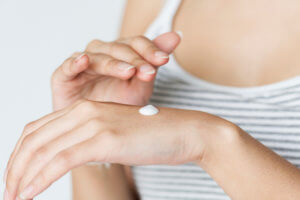
It shouldn’t happen. It really shouldn’t happen. A blemish in the product that’s supposed to prevent blemishes? This week we’re talking all about mold and what happens when it makes itself at home in your favorite skincare products.
Despite their use of preservatives, mold can still pop up in things like cleansers and moisturizers – albeit at a much slower pace than it would in a loaf of bread. Expiry dates exist for a reason and must not be ignored, not to mention the fact that – according to Texas-based dermatologist, Ted Lain – even preservatives will not always be 100% effective for warding off fungus. Coupled with an increasing emphasis on all things natural, our reliance on chemical preservatives may be misguided.
It’s vital to know the tell-tale signs, therefore – unless you want the very thing that’s supposed to stop break-outs to inadvertently cause them.
Machiavellian Mold
“Moisture, warmth and food are all necessary for mold to grow”, Florida-based dermatologist, Roberta Del Campo says, meaning where you store your skincare products is crucial to extending its shelf life.
Yet – unlike its non-cosmetic peers – mold in skincare products can be even more Machiavellian as it’s guilty of the ultimate treachery – camouflaging itself into the same color as your product – not to mention the added difficulty of spotting any unwanted visitors in opaque bottles and tubes.
And what can you expect to happen if you slather a contaminated product on your skin? “For those with a normal immune system and skin that is not inflamed or irritated, there is little risk that mold will cause much of an issue”, Ted told Allure magazine. “For those with a compromised immune system or if the barrier function of skin is limited, the mold could cause an infection.” You should also expect the possibility of a rash, eczema, hives or – when used on the face – “itchy or swollen eyes”, according to Roberta, whilst makeup to the stars, Nikki Fontaine, is reported to have warned against clogged pores and breakouts.
Top Tips
- Check the ingredients before purchasing – without natural preservatives, mold is likely to grow much quicker – especially in water-based products. “It’s really important that we push people away from the idea of preservative-free”, deputy director of research for the Environmental Working Group, Nneka Leiba, told Well + Good. “What we really want to see is innovation and testing to find newer preservatives that are safer.” Bottom line: If a product has water in it, it needs to have a preservative in it – whether natural or chemical.
- Opt for products that come with an airless pump – or buy your own to add on after.
- Store in a cool, dry, dark place. You can even make like Rihanna’s makeup artist and invest in a dedicated mini cooler (or not so mini, depending on the size of your collection!).
- Decant into glass containers.
- Keep lids on tight to “prevent moisture from penetrating into them”, says Roberta.
- Bin as soon as the expiry date passes – however hard it may seem.
- Clean and sanitize “the implements used to apply skincare and makeup products”, Nikki is reported to have said.
- Use testers with caution: A 2004 study found these bottles riddled with staph, strep and E. coli.
- “Wash hands before applying cosmetics, close cases or jars after use, read cosmetic labels carefully and replace as directed, replace applicators frequently, or use disposable makeup applicators”, senior microbiologist, John F. Krowka is reported to have said.
It’s great that beauty is in the eye of the beholder … as long as that beholder is not mold!
from Mold Blogger https://moldblogger.com/clearing-things-up-mold-in-skincare-products/
Mold Remediation Baltimore
No comments:
Post a Comment